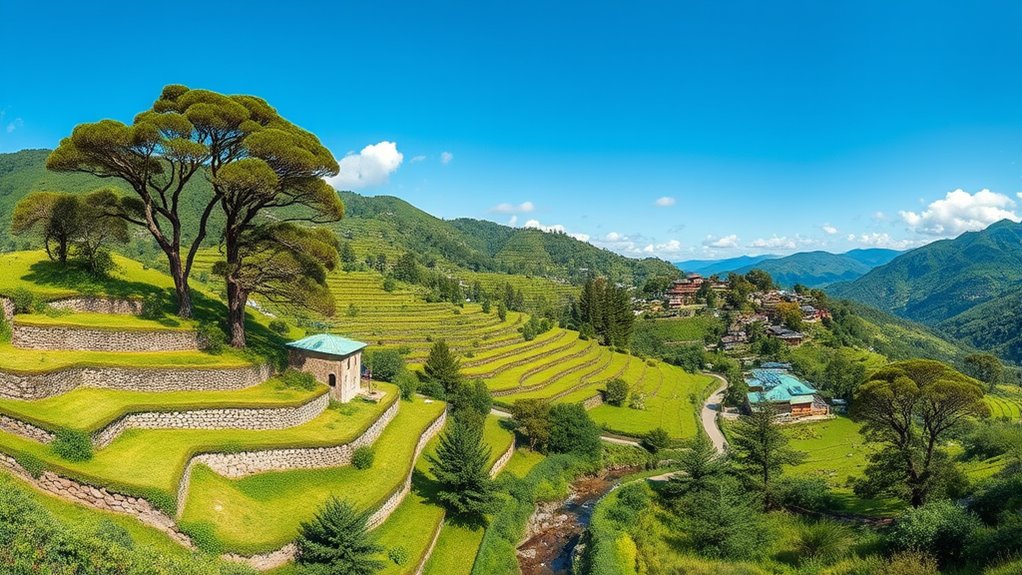SITES guides you to create resilient, sustainable landscapes by emphasizing ecological design principles that support natural processes and biodiversity. It encourages you to choose native plants, use permeable and recycled materials, and manage stormwater effectively. By focusing on soil health, water retention, and low-impact practices, you can develop adaptable outdoor spaces that withstand environmental stresses. Exploring these strategies further reveals how you can make meaningful contributions to landscape resilience and sustainability.
Key Takeaways
- SITES provides guidelines for sustainable landscape design, construction, and maintenance emphasizing ecological principles.
- It promotes resilience through native plant use, stormwater management, and natural process integration in urban environments.
- SITES encourages material selection of recycled, local, and low-impact resources to reduce environmental footprints.
- It advocates for holistic approaches focusing on soil health, water efficiency, and adaptable landscapes.
- SITES supports creating resilient, ecologically responsible landscapes that withstand environmental stresses and enhance biodiversity.

SITES, or the Sustainable Sites Initiative, plays a crucial role in promoting landscape sustainability by guiding the design, construction, and maintenance of outdoor spaces. As someone invested in creating resilient, environmentally responsible landscapes, understanding how SITES encourages urban resilience is essential. Urban resilience refers to a city’s ability to withstand and adapt to environmental challenges like climate change, flooding, and heat waves. SITES emphasizes ecological design principles that enhance this resilience by integrating natural processes into urban environments. You’ll find that incorporating native plants, permeable surfaces, and stormwater management techniques aligns with SITES standards and strengthens a city’s capacity to absorb shocks. Ecological design isn’t just about aesthetics; it’s about working with nature to create systems that are self-sustaining and adaptable. By prioritizing native vegetation, you reduce irrigation needs and support local ecosystems, which in turn increases urban resilience. This approach minimizes the urban heat island effect, manages stormwater efficiently, and promotes biodiversity—all key to designing resilient landscapes.
When you follow SITES guidelines, you actively contribute to creating outdoor spaces that are less vulnerable to environmental stressors. For example, selecting drought-tolerant plants reduces water consumption during dry periods, making landscapes more sustainable in the face of changing climate patterns. Similarly, designing for water retention, through rain gardens or green roofs, helps mitigate flooding risks in urban areas, protecting infrastructure and communities alike. Ecological design also involves thoughtful material choices—using recycled, locally sourced, and low-impact materials—reducing the environmental footprint of your project. These decisions not only support sustainability but also bolster the resilience of the landscape over time, as materials age gracefully and require less maintenance.
SITES encourages you to think holistically about every element, from soil health to water management, fostering landscapes that thrive amidst environmental challenges. You’re empowered to create spaces that aren’t just beautiful but are functional, adaptable, and resilient. This framework pushes you to innovate, integrating ecological processes into urban settings to support long-term sustainability. By adhering to SITES standards, you’re actively shaping landscapes that can withstand future stresses, support local ecosystems, and promote a healthier, more resilient urban environment. Through ecological design, you become part of a broader movement that values resilience, sustainability, and the harmony between human activity and nature.
Frequently Asked Questions
How Do SITES Criteria Adapt to Climate Change Impacts?
You adapt site criteria to climate change impacts by prioritizing climate resilience and implementing adaptive strategies. You assess risks like flooding, heat waves, and droughts, then incorporate design features that mitigate these effects. This involves selecting resilient plant species, improving water management, and enhancing natural buffers. By continuously updating these criteria, you guarantee sites remain sustainable and functional despite changing climate conditions, fostering long-term resilience and ecological health.
What Are the Costs Associated With Implementing SITES Standards?
Costs can crush your budget, but investing in urban resilience and green infrastructure pays off. You’ll face expenses for planning, purchasing eco-friendly materials, and installing sustainable systems. Maintenance costs may also rise, but they’re offset by long-term savings and environmental benefits. While initial investments might seem steep, the payoff includes improved ecosystem health, climate adaptation, and enhanced community well-being, making your site more resilient and sustainable in the face of changing climate impacts.
How Can Small Projects Achieve SITES Certification?
You can achieve sites certification for small projects by focusing on green infrastructure and soil restoration. Start by incorporating native plants and permeable surfaces to manage stormwater naturally. Prioritize soil health through restoration efforts, reducing the need for fertilizers and irrigation. Keep your design simple and cost-effective, demonstrating a strong commitment to sustainability. Regularly document your progress, and seek guidance from certification resources to guarantee your project meets all standards efficiently.
What Role Do Local Communities Play in SITES Projects?
You play a crucial role in site projects by fostering community engagement and supporting cultural preservation. When you involve local communities, you guarantee their voices influence decisions, making projects more sustainable and respectful of local traditions. This active participation helps protect cultural heritage, enhances project acceptance, and creates a sense of shared ownership. Your efforts build stronger connections, ensuring the project’s long-term success and meaningful integration into the community fabric.
How Does SITES Address Biodiversity Conservation?
You can support biodiversity conservation by prioritizing habitat preservation and promoting native species. This approach helps maintain ecological balance and guarantees local wildlife thrives. By selecting native plants, you reduce the need for extra resources and create resilient ecosystems. Addressing biodiversity means actively protecting habitats and encouraging native species, which sustains the natural environment for future generations. Your efforts directly contribute to healthier, more sustainable landscapes.
Conclusion
By now, you understand that embracing sustainable sites and landscapes isn’t just a trend—it’s your mission. As you plan and create, remember that every choice shapes the future, much like the architects of ancient Rome who built lasting legacies. Don’t let progress become your Trojan horse; instead, foster harmony with nature. Your commitment today guarantees these landscapes thrive tomorrow, proving that even in a digital age, the earth remains your most valuable blueprint.










